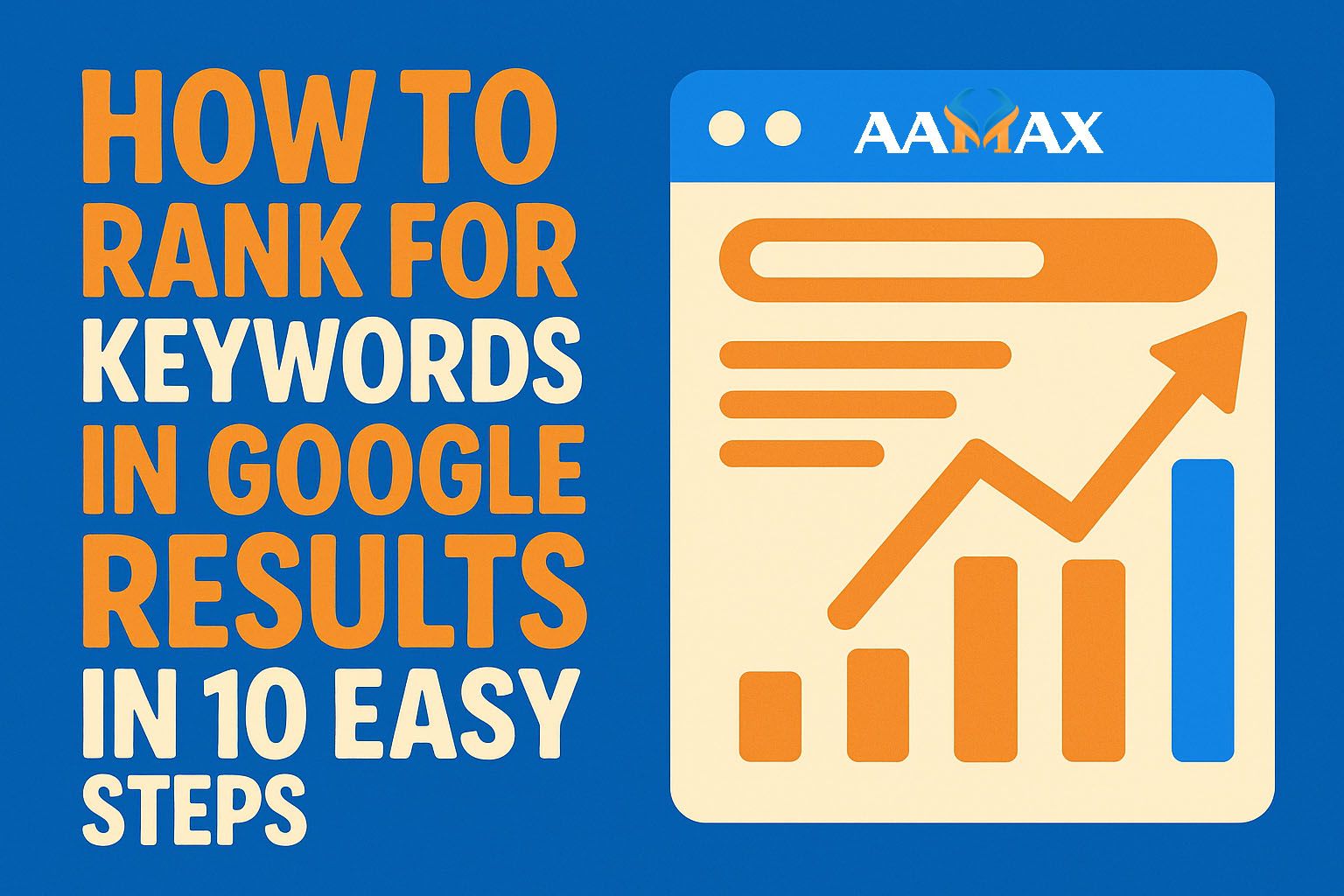
How to Rank for Keywords in Google Results in 10 Easy Steps
Getting your website to rank on the first page of Google can seem daunting. With billions of web pages competing for attention, how do you ensure your content stands out? The good news is that with a strategic and consistent approach, you can rank for your target keywords—even in competitive niches.
Whether you're a small business owner, blogger, or marketing professional, this guide will walk you through 10 actionable steps to help you dominate the search engine results pages (SERPs).
1. Understand the Importance of Keyword Research
Before you can rank for anything, you need to know what you want to rank for. Keyword research is the foundation of every successful SEO strategy.
What Is Keyword Research?
Keyword research involves identifying the specific terms and phrases your target audience types into Google when looking for information, products, or services.
Tools for Keyword Research
Use tools like:
- Google Keyword Planner
- Ahrefs
- SEMrush
- Ubersuggest
- Moz Keyword Explorer
These tools help you find keywords based on search volume, competition, and relevance.
Long-Tail vs. Short-Tail Keywords
- Short-tail keywords: “shoes” (high volume, high competition)
- Long-tail keywords: “best running shoes for flat feet” (lower volume, lower competition, more targeted)
Long-tail keywords are often easier to rank for and attract more qualified traffic.
2. Analyze Your Competition
Once you've identified potential keywords, analyze the top-ranking pages for those keywords. This gives insight into what you’re up against.
What to Look For:
- Domain authority of competing websites
- Type of content (blog post, video, product page, etc.)
- Content length and structure
- Keyword usage in title, headers, and URL
- Number and quality of backlinks
Tools to Use:
- Ahrefs Site Explorer
- Moz Link Explorer
- SEMrush Domain Overview
Competitive analysis helps you understand how much effort it will take to outrank your competitors.
3. Create High-Quality, Keyword-Optimized Content
Google prioritizes helpful, authoritative, and user-friendly content. After keyword research and competitive analysis, start creating content that provides more value than what’s already ranking.
Content Optimization Best Practices:
- Use your primary keyword in the title, meta description, first 100 words, and headings (H1, H2).
- Include semantic keywords (LSI keywords) that relate to your topic.
- Ensure the content is original and comprehensive.
- Use bullet points, images, and videos to enhance readability.
- Aim for long-form content (1000+ words) when possible.
Google’s algorithm loves well-structured content that thoroughly answers search queries.
4. Optimize On-Page SEO Elements
Even the best content won’t rank well if it’s not properly optimized. On-page SEO refers to the elements you can control directly on your website.
Key Elements to Optimize:
- Title Tag: Include your keyword naturally and keep it under 60 characters.
- Meta Description: Summarize the content in 150–160 characters; entice clicks.
- URL Slug: Short, descriptive, and keyword-rich (e.g.,
/rank-keywords-google). - Header Tags: Use H1 for the title, H2s for main sections, and H3s for sub-sections.
- Alt Text for Images: Describe images using keywords where appropriate.
- Internal Linking: Link to other relevant pages on your website to improve crawlability.
Proper on-page SEO ensures your content is easily understood by both users and search engines.
5. Improve Website Speed and Mobile Usability
Google uses page speed and mobile-friendliness as ranking signals. A slow or poorly optimized site can drive users away and hurt your rankings.
How to Improve Site Speed:
- Use fast and reliable hosting
- Compress images with tools like TinyPNG or ShortPixel
- Minimize JavaScript and CSS files
- Enable browser caching
- Use a content delivery network (CDN)
Mobile Optimization Tips:
- Use responsive design
- Avoid pop-ups that block content
- Ensure buttons and text are touch-friendly
- Test mobile usability with Google’s Mobile-Friendly Test
A fast, mobile-optimized site improves user experience and boosts your SEO.
6. Build High-Quality Backlinks
Backlinks remain one of the most important ranking factors in Google’s algorithm. A backlink is a vote of confidence from another site, signaling that your content is trustworthy and valuable.
How to Build Backlinks:
- Guest blogging on authoritative sites in your niche
- Reaching out to sites that mention your brand but don’t link (link reclamation)
- Creating share-worthy content like infographics, research studies, or how-to guides
- Listing your business in reputable online directories
- Participating in industry forums or contributing to Q&A platforms like Quora and Reddit
Focus on quality over quantity. A few links from high-authority sites can be more impactful than dozens of low-quality ones.
7. Leverage Local SEO (If Applicable)
If you run a local business, local SEO can drive highly targeted traffic and customers to your site.
Local SEO Tips:
- Create and optimize your Google Business Profile
- Get listed on local directories (Yelp, Bing Places, etc.)
- Use location-specific keywords (e.g., “plumber in Chicago”)
- Encourage customer reviews
- Ensure NAP consistency (Name, Address, Phone Number) across all listings
Local SEO helps you rank for “near me” searches and reach customers in your geographic area.
8. Utilize Structured Data (Schema Markup)
Structured data helps search engines understand your content better. It can also lead to rich snippets in search results, improving click-through rates.
Types of Schema You Can Use:
- Article
- Product
- FAQ
- How-To
- Local Business
- Breadcrumb
You can implement schema markup manually or use plugins like Yoast SEO, Rank Math, or Schema Pro.
Test Your Schema:
Use Google’s Rich Results Test or Schema Markup Validator to ensure your structured data is correctly implemented.
9. Monitor Your Results and Adjust Accordingly
SEO isn’t a “set it and forget it” activity. Regular monitoring helps you understand what’s working—and what’s not.
Tools to Track SEO Performance:
- Google Search Console: Check indexing status, search queries, CTR, and more.
- Google Analytics: Monitor traffic sources, bounce rates, and user behavior.
- Ahrefs or SEMrush: Track keyword rankings, backlinks, and site health.
Key Metrics to Watch:
- Keyword rankings
- Organic traffic
- Bounce rate
- Time on page
- Click-through rate (CTR)
- Conversion rate
Be ready to optimize underperforming content, update outdated posts, and double down on what's working.
10. Stay Updated With Google’s Algorithm Changes
Google makes thousands of updates to its search algorithm every year. Major core updates can significantly impact your rankings overnight.
How to Stay Informed:
- Follow Google Search Central Blog
- Engage with SEO communities on Twitter, LinkedIn, and Reddit
- Subscribe to industry newsletters (Search Engine Journal, Moz, Ahrefs)
- Use tools that track algorithm updates (e.g., SEMrush Sensor, Mozcast)
Staying updated ensures you’re not blindsided by changes and can adapt your strategy accordingly.
Bonus Tip: Consider Hiring SEO Experts
If this seems overwhelming—or if you’d rather focus on running your business—consider hiring a professional SEO agency.
One such expert is AAMAX, a full-service digital marketing company that offers Web Development, SEO, and Digital Marketing services. Their team helps businesses like yours climb the search rankings, drive more traffic, and increase revenue.
Whether you're starting from scratch or looking to improve your existing SEO strategy, working with a partner like AAMAX can provide the guidance and execution needed to see real results.
Final Thoughts
Ranking for keywords in Google isn’t a mystery—it’s a process. By following the 10 steps outlined above, you’ll be well on your way to improving your visibility, driving more traffic, and growing your online presence.
To recap, here are the key steps:
- Do thorough keyword research
- Analyze your competitors
- Create high-quality content
- Optimize your on-page SEO
- Ensure fast, mobile-friendly website performance
- Build high-quality backlinks
- Leverage local SEO if applicable
- Use structured data
- Monitor your results
- Stay updated with Google’s algorithm changes
Start implementing these steps today—and if you need expert help, AAMAX is just a click away.







